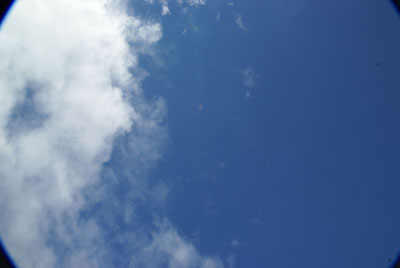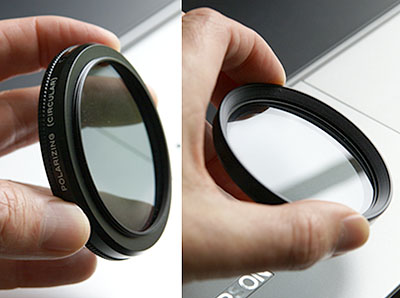16-80mm filter vignetting – myth or fact?
THE PROBLEM of darkened extreme corners with the 16-80mm CZ Sony lens definitely exists. They are there in many of my shots, with or without SSS anti-shake enabled, significant softly darkened corners. Everyone is saying this must be due to filters, and at least one of Forum regulars has emailed Zeiss about this issue (and got a reply almost admitting that the lens falls short of ideal design). But is it?
I took the A100 out this morning because I’m writing a test for f2 Freelance Photographer later on, and wanted to check my facts. I only just have enough sky for 16mm without including treetops, and hundreds of starlings kept divebombing me because the hens’ feeder was close by and they have been raiding all the henfood. First, I turned SSS off. Then I set the camera to manual focus, and the 16-80mm to 16mm, and infinity. Next I set +1 exposure compensation knowing that the clouds would persuade the camera to underexpose, and f/22 with Aperture Priority (A).
Why? At 16mm, the lens has its widest angle. At infinity focus, it is also at its widest actual coverage. At f22, any intruding filter, mount or lenshood would be most sharply imaged. Here is what I found.

This is the result with a B+W 62E Slim 010 1x MC filter fitted and lenshood SH0005 in place. I see no sudden corner vignetting of a mechanical kind but moderate fall off in illumination, probably caused by lens/sensor issues at f22.

This is the same with the lenshood removed (note the small flare patch). Any differences are due to the exposure, the lenshood can not actually create any soft shading; if it was imaged, you would see it sharply.

And here is without the filter. Again, if you think it’s improved, it’s wishful thinking. The filter, as we will see later, would appear sharply in the images with it present.

This is a shot with the Minolta 62mm Circular Polarizer, the original design which has a 62mm rear thread and a 72mm front diameter (no thread, just a flared ribbed surround as found in many lenses between the front element and the rim). It’s extremely dark and I have not adjusted these sRGB Natural JPEGs at all, for obvious reasons. But you can see, again, that this filter is not cutting into the image.

Here, I have used a Minolta 62mm to 72mm stepping ring (we have these for sale – www.iconpublications.com) and a Minolta 72mm UV AC filter. I could not find my 72mm circular polariser to test. As you can see, neither the stepping ring nor the regular Minolta filter interferes with the image.

Now this is what you get from an older Hoya thick polarizer. Sure, you can’t use it, and the colour cast is another good reason to steer clear! My sensor is not centred, or my lens is not centred. This is typical of all DSLR, unconnected to SSS/AS. This kind of accuracy is about what you get from DSLR sensor positioning. Now what if your sensor was more misaligned than mine? You might be seeing asymmetric mechanical vignetting from slimmer filters.

Next one – a standard thickness Rodenstock UV filter. I can see that we have a sharp cutoff in the corners at the left side, where the sensor was tending to be pushed over to. Active SSS could make it move further this way. You could get noticeable cutoff with a normal, not excessively thick, UV filter at 16mm.

Here’s what you get when the lens is opened up to f/3.5 – you will see that corner illumination has a strong falloff. This is not the same as filter vignetting, but it may be caused by mounting components in the lens itself, or a narrow constriction in the lens design to allow lighter weight focusing or zoom components. Lenses with IS/VR often have this look, because the makers must give the design a wasp waist. After squeezing the optical train into a corset to get a waist small enough to work with optical stablisation, severe fall-off can result as well as asymmetric aberrations when the IS/VR is active. SSS is technically better, but not if the sensor wanders out of the image circle. SSS movement at 16mm is in the order of hundredths to tenths of a millimetre unless you are riding a rollercoaster when shooting. Even so, it’s tight.

Finally, this is the bare lens at f/8. Illumination seems optimum, better than the f/22 result or the f/3.5 result. Overall, I feel that issues with the lens vignetting have other causes. I do not think SSS is a major one, since prior to shooting these pix, I was working with SSS turned off and got this result, using my slimline B+W and the hood fitted as normal:

You will see that hint of darkening in this 1/500th at f/8 shot, top left corner (the top right could be emphasized by the cloud changing to blue sky at that point). There is just a slight touch in the bottom corners. This was not focused on infinity, but focused on the statue plinth of the Hawick Horse (the local buses say ‘Horse’ for destination and everyone except the tourists knows what this means!). I zoomed to 80mm to focus, and zoomed back to 16mm, as the A100 simply won’t focus the 16-80mm accurately enough to distinguish between the plinth and the distant buildings at 16mm.
What is really causing the fall-off?
Perhaps it’s an internal issue. Some aspect of the internal baffles and mounting of the lens is leading to a sharp vignetting of the image circle, easily seen if you put the lens on a full frame 35mm body and study the circle on-screen. It seems that focusing closer, not on infinity, may increase vignetting at 16mm. I made a test at f/3.5 focused on minimum distance, and was not able to see any change. Perhaps particularly focus distances, using AF rather than manual focus, create this slight corner vignetting. Perhaps samples of the lens vary and some will be more prone to vignetting or filter cut-off than others.
My conclusion is that Zeiss flew this one a bit too close to our heads but didn’t actually crash into the crowd. We could have used a margin of comfort. And we must remember NOT to use old Hoya polarizers, or even the latest B+W Slimline polarizer which Zeiss confirm will cause cut-off (thanks for relaying this information, Dale, and for having the initiative to hit Zeiss directly with your complaint!). For UV or other standard filters, stick to the slimmest filters around, like Hoya Pro1 Digital Slimline or B+W Slim.
The original Minolta polarizer (Type 1, Circular Polarizer, 62mm) is shown below as it’s not familiar to everyone. This is how Minolta made their polarizers from the early 1980s onwards, and this type of flared w/a mount was needed for the 20mm f/2.8 MD (55mm thread), 24-35mm MD zoom, 24-50mm MD zoom, all 24mm fixed focal length variants, the 17mm f/4 MD, the 20mm f/2.8 AF, 24-50mm f/4 AF and later on for the 24-85mm and 24-105mm AF. It was originally made in 49mm, 55mm and 72mm linear-pol types, then changed to circular pol in 1985. The 62mm size was later added. Minolta Type 2 Circular polarizers abandon this beautifully smooth design, which has about the sweetest action of any polarizer I know, for a conventional slimline type. The 77mm pol, which is designed to be operated through the lens-hood door of the 70-200mm SSM, has only been made in a slimline variant.

Really, we can’t blame Zeiss for a 24mm equivalent lens needing a special polarizing filter as Minolta themselves designed their polarizers to overcome vignetting, which happened on many of their regular ultra-wides and wide zooms 25 years ago. B+W make a 62mm Käsemann circular polarizer, multicoated, in a wide-angle mount very similar to the Minolta design – it’s an expensive beast. You can download a very good complete B+W filter catalogue which includes information on this from Robert White, UK dealer: http://www.robertwhite.co.uk/pdf/B+W_filter_handbook.pdf
David

Pingback: Photoclub Alpha » Blog Archive » No chance of widening my horizons...